Germany, often globally recognized for its industrial efficiency and philosophical heritage, holds an equally rich tapestry of deep-rooted cultural and spiritual traditions. These practices, far from being mere folklore, are the foundational expressions of community cohesion, historical memory, and shared values. They reflect a history deeply influenced by Germanic paganism, the Roman Empire, and centuries of Christian faith, particularly after the Protestant Reformation.
At Spiritual Culture, we believe the true value of a tradition lies in its spiritual impact—its ability to connect generations, reinforce moral lessons, and provide a sense of continuity. As of the Current Time of Writing, these German customs continue to thrive, not just as tourist attractions but as living, evolving threads of the national identity, fostering Heimat (homeland) and Gemeinschaft (community) across its diverse regions.
The following guide illuminates the ten most important German cultural traditions, ranked based on their historical significance, geographical prevalence, spiritual depth (often rooted in Christian or pre-Christian cycles), and their current-day influence on German society. This ranking is a celebration of the enduring human spirit expressed through German heritage.
Table of the Top 10 German Cultural Traditions by Spiritual and Historical Influence
| Rank | Tradition Name | Primary Focus | Spiritual/Historical Origin | Prevalence/Status (November 2025) |
|---|---|---|---|---|
| 1 | Weihnachtsmärkte (Christmas Markets) & Advent | Seasonal Celebration, Community | Christian Advent & Medieval Trade | Nationwide; Major cultural and economic event. |
| 2 | Karneval/Fasching/Fastnacht | Pre-Lenten Festivity, Social Critique | Pagan Winter Rituals & Christian Liturgical Calendar | High in Rhineland (Cologne, Düsseldorf) & Swabia. |
| 3 | Ostern (Easter) and Osterbaum | Paschal Cycle, Rebirth, Family | Christian Resurrection & Pagan Spring Rites | Nationwide family and religious observance. |
| 4 | Sankt Nikolaus Tag (St. Nicholas Day, Dec 6) | Charity, Moral Education of Children | Saint Nicholas of Myra (4th Century) | High engagement, particularly among families with children. |
| 5 | Maypole Raising (Maibaum) | Welcome of Spring, Fertility | Pagan Germanic/Celtic Spring/Fertility Rites | Strong in Bavaria and Southern/Rural communities. |
| 6 | Punctuality and Orderliness (Ordnung) | Societal Value, Respect, Efficiency | Protestant Work Ethic & Enlightenment Logic | Core, defining national cultural value/ethos. |
| 7 | Oktoberfest and Volksfeste | Regional Harvest/Anniversary Celebration | 1810 Royal Wedding Anniversary (Bavaria) & Harvest | Major global festival (Oktoberfest); countless smaller regional Volksfeste. |
| 8 | The Reformation and Lutheran Heritage | Intellectual/Religious Freedom, Individual Faith | Martin Luther’s 95 Theses (1517) | Deep influence on language, education, and cultural identity (especially Northern/Eastern Germany). |
| 9 | The Sunday Rest (Sonntagsruhe) | Sabbath Observance, Leisure, Family | Judeo-Christian Tradition & Labor Laws | Nationwide legal and social expectation of stillness. |
| 10 | Wanderlust (Passion for Hiking/Nature) | Connection to Nature, Romanticism, Freedom | Romantic Movement (18th/19th Century) | Widespread leisure activity and philosophical ideal. |
✨ The Top 10 Most Important German Cultural Traditions
10. Wanderlust (Passion for Hiking/Nature)
The concept of Wanderlust, literally meaning a ‘desire to wander,’ is more than just a word for travel; it embodies a deep, cultural connection to nature and the philosophical search for self. Rooted in the German Romantic movement of the 18th and 19th centuries, this tradition sees walking and hiking not merely as exercise but as a profound, contemplative journey. As of the Current Time of Writing, Germany’s network of well-maintained hiking trails, from the Black Forest to the Alps, attests to the ongoing commitment to this active, outdoor lifestyle, influencing everything from national parks to personal weekend planning.

The spiritual impact of Wanderlust lies in its insistence on quiet communion with creation. It is a secular pilgrimage, where the rhythmic movement and exposure to the sublime beauty of nature facilitate reflection and emotional renewal. The ranking here recognizes it as a crucial expression of the German soul—a search for truth and authentic feeling (Sehnsucht) found outside the structured world. It teaches the virtue of endurance and the simple yet profound lesson that clarity often comes on the journey, not just at the destination.
The preservation value of Wanderlust is evident in Germany’s strong ecological consciousness and commitment to preserving natural landscapes. By encouraging its citizens to engage directly and respectfully with nature, the tradition instills a foundational moral lesson of stewardship. It reminds us that our personal peace is inextricably linked to the health and beauty of the world we inhabit.
Cultural/Spiritual Highlights
- Rooted in the Romantic-era search for the Sublime in nature.
- The concept of Waldeinsamkeit (forest solitude) facilitates deep meditation.
- Millions of Germans are members of hiking or nature-protection clubs.
- Philosophically links individual freedom to open landscapes.
9. The Sunday Rest (Sonntagsruhe)
The tradition of Sonntagsruhe, or Sunday rest, enforces a nationwide cessation of commerce and noisy activity, creating a day dedicated primarily to family, leisure, and quiet contemplation. This legal and social expectation, robustly upheld as of the Current Time of Writing, mandates the closure of most shops and prohibits loud activities like drilling or mowing lawns. Its origins are squarely in the Judeo-Christian concept of the Sabbath, a day of rest and holiness, which became deeply integrated into the cultural fabric of the nation.
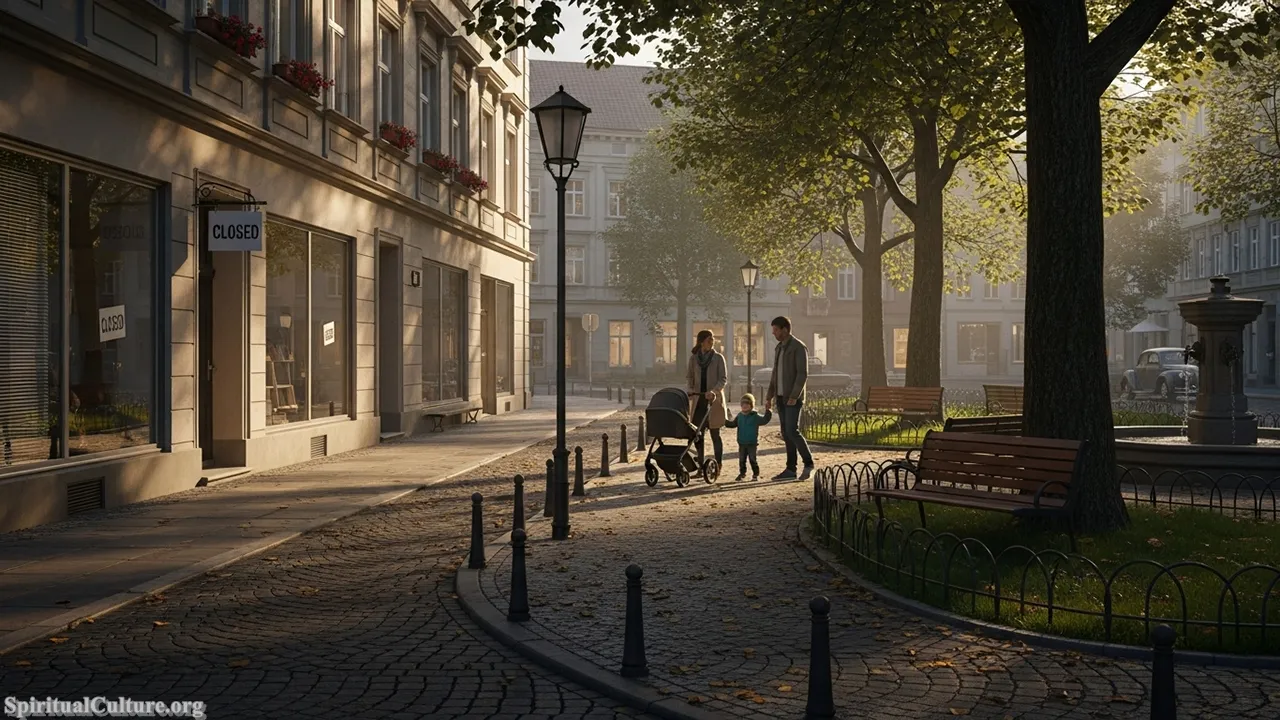
The spiritual importance of the Sonntagsruhe is that it forces a collective moment of stillness and separation from the demands of work and consumption. This ranking acknowledges its deep impact on daily life, creating a sacred, communal time for intentional reconnection—with family, with community (often through church or communal sport), or with one’s own inner life. It is an act of spiritual discipline, prioritizing being over doing, and reinforcing the idea that productivity is not the sole measure of human worth.
The moral lesson of this tradition is one of human dignity and social contract. By protecting the day off for everyone, including low-wage retail workers, it underscores a collective responsibility for human well-being. It serves as a necessary cultural and social respite, teaching the modern world the preservation value of slowing down and respecting a shared rhythm of rest.
Cultural/Spiritual Highlights
- Directly tied to the Christian Sabbath commandment (third commandment).
- Legal protection for retail workers and enforced noise restrictions.
- Promotes the importance of the nuclear and extended family unit.
- A cultural practice that enforces a nationwide, shared moment of calm.
8. The Reformation and Lutheran Heritage
Germany stands as the birthplace of the Protestant Reformation, a seismic spiritual event initiated by Martin Luther in 1517. The heritage of this movement remains a core pillar of German culture, shaping not just its religious denominations but also its language, educational values, and political philosophy. Even as of the Current Time of Writing, the legacy of Luther’s translation of the Bible into common German remains a linguistic and unifying cultural touchstone, deeply influencing the national character, especially in the central and northern regions.

The primary reason for its ranking is its profound spiritual and intellectual impact: the Reformation championed the individual conscience and the direct relationship between the believer and the divine, without the mandatory mediation of an expansive hierarchy. It democratized spirituality and literacy, giving rise to a culture that prizes critical thinking, direct communication, and a strong sense of personal responsibility. This spiritual individualism is a core, though often subconscious, element of the modern German psyche.
The preservation value of the Reformation heritage lies in sites like Wartburg Castle (a UNESCO World Heritage Site), where Luther translated the New Testament. It is a lesson in intellectual bravery and the power of one individual’s conviction to challenge entrenched authority. This tradition underscores the profound belief that faith and reason are inseparable tools for understanding truth.
Cultural/Spiritual Highlights
- Led to the standardization of the German language through Luther’s Bible translation.
- Emphasized the priesthood of all believers, decentralizing religious authority.
- Fostered a strong Protestant work ethic and high value on education.
- Sites like the Luther Memorials in Eisleben and Wittenberg hold UNESCO status.
7. Oktoberfest and Volksfeste
While often seen purely through the lens of beer and revelry, the Volksfest (People’s Festival) tradition, epitomized by Munich’s annual Oktoberfest, is a vital cultural and historical practice. Oktoberfest itself began in 1810 as a celebration of Crown Prince Ludwig’s marriage, a royal occasion intended to unite the people. Today, as of the Current Time of Writing, thousands of smaller Volksfeste—spanning wine festivals, shooting festivals, and harvest fairs—exist regionally, each serving as a non-religious, yet deeply communal, expression of local pride and unity.
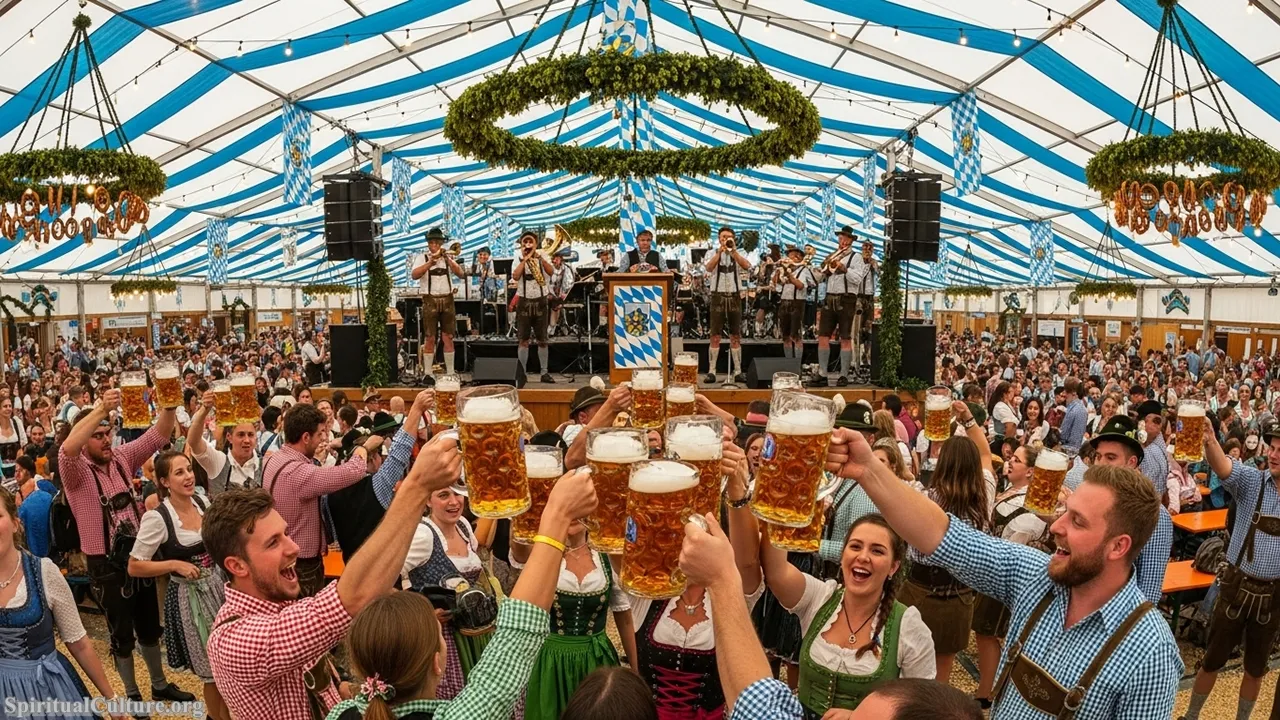
The spiritual impact of Volksfeste lies in their role as cyclical, celebratory releases from the structure and order of everyday German life. They are acts of cultural catharsis, where the emphasis shifts to exuberant shared experience, traditional music (like Bavarian Oompah), and the wearing of heritage clothing (Tracht, such as Dirndl and Lederhosen). This collective joy ranks as a high-value spiritual practice, fostering a sense of belonging (Gemeinschaft) that transcends social and economic divisions.
The moral lesson of this tradition is the necessity of shared public happiness and the importance of remembering local roots. It is a preservation of regional identity in an increasingly globalized world, demonstrating that community bonds are strengthened through shared ritual—even when that ritual involves a giant tent and a pint of local beer. They teach the value of celebrating the simple abundance of life.
Cultural/Spiritual Highlights
- Acts as a powerful, unifying expression of regional identity and pride.
- Rooted in historical anniversaries, agricultural cycles, and harvest feasts.
- The atmosphere facilitates a collective, celebratory release (carpe diem).
- Preserves local music, culinary arts, and traditional textile heritage (Tracht).
6. Punctuality and Orderliness (Ordnung)
Punctuality (Pünktlichkeit) and a high regard for efficiency and order (Ordnung) are not mere quirks but fundamental, universally accepted cultural values that define the German ethos. This tradition is a secular spiritual practice, emphasizing respect for others’ time and resources. As of the Current Time of Writing, this value underpins the efficiency of public services, the structure of the work week, and all personal appointments, creating a reliable and predictable social environment that is often envied globally.
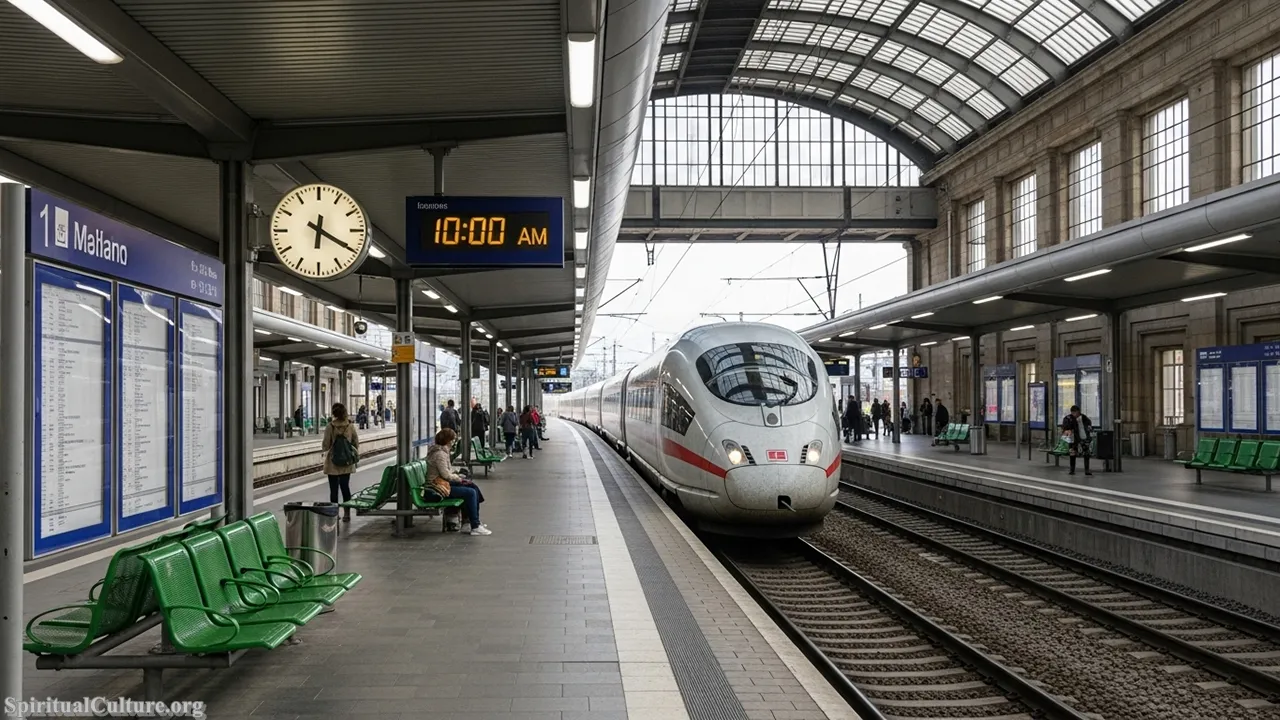
The spiritual impact of Ordnung is rooted in the belief that external structure leads to internal peace and fairness. The ranking recognizes this as a moral system: being on time is an expression of respect and reliability, demonstrating that one values the other person’s life as much as one’s own. Philosophically, it links back to Kantian ethics, where dutiful action and rational planning are viewed as moral imperatives. In essence, it is a spiritual practice of societal mindfulness.
The preservation value of this ethos is its role in maintaining a highly functioning, cohesive society. It teaches the vital moral lesson that personal discipline contributes directly to collective well-being. By upholding shared standards of conduct, German society demonstrates a deep, unwritten social contract based on trust, foresight, and mutual dependability.
Cultural/Spiritual Highlights
- Punctuality is viewed as an act of fundamental respect for others.
- Reflects the Protestant-influenced value of duty, diligence, and foresight.
- Creates a high level of societal reliability and trust in public systems.
- An ethical practice where personal discipline benefits the entire community.
5. Maypole Raising (Maibaum)
The raising of the Maibaum (Maypole) on the night of April 30th/May 1st is one of Germany’s most visually striking cultural practices, particularly in the southern region of Bavaria. This centuries-old tradition involves erecting a towering pole, often stripped of bark and decorated with wreaths, ribbons, and small signs detailing the village’s trades or history. While May Day is now a secular holiday for labor rights (as of the Current Time of Writing), the Maibaum ceremony retains its older, communal, and mystical flavor.
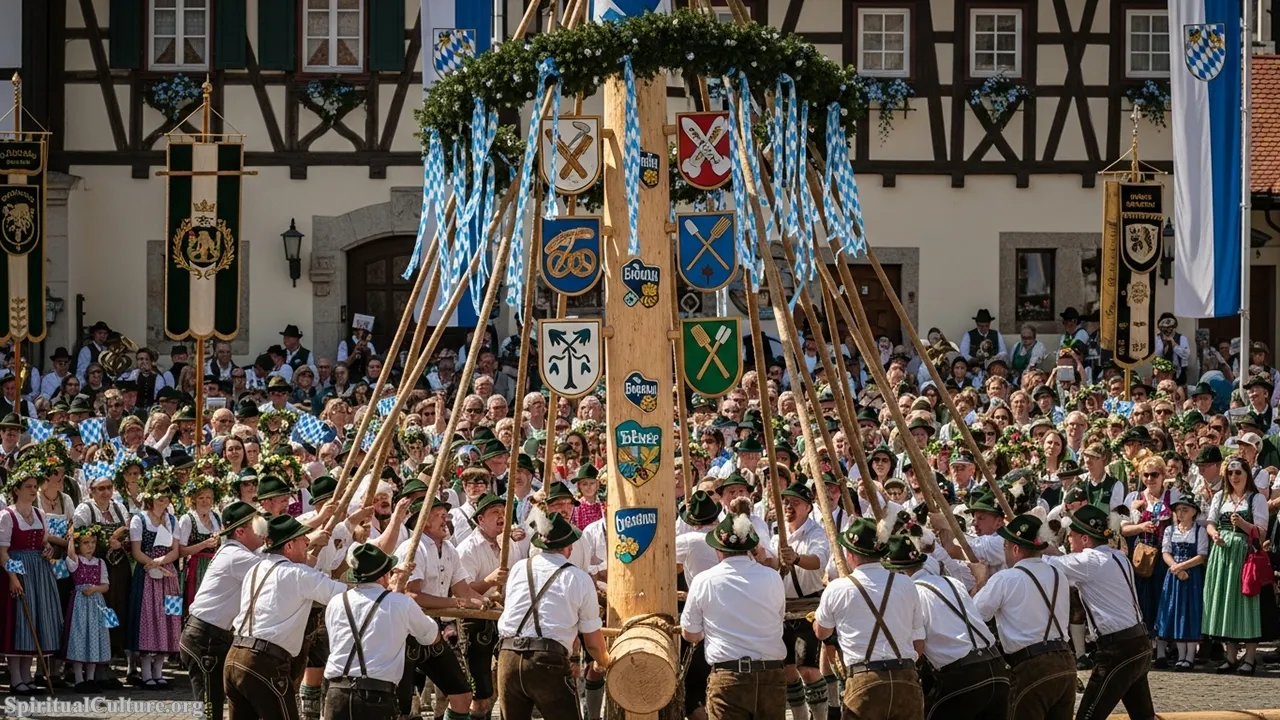
The spiritual depth of the Maypole tradition is its unambiguous link to pre-Christian, pagan fertility and renewal rites. The act of raising the tall tree—a communal endeavor often requiring specialized skills and strength—symbolizes the triumph of life and warmth over the harshness of winter. The pole itself acts as an axis mundi, connecting the earth and the heavens, and is ritually guarded by young men, symbolizing the community’s protection of its renewal and abundance. The ranking reflects its direct spiritual lineage to the cycles of the earth.
The moral lesson is the absolute importance of community cooperation and inter-generational pride. The elaborate communal effort of raising the pole and the subsequent May dance reinforces social bonds. It is a preservation of seasonal joy, teaching that the transition between life’s phases is always cause for shared, collective celebration.
Cultural/Spiritual Highlights
- Directly descends from ancient pagan spring and fertility rituals.
- The pole is an axis mundi (world axis) symbol of the connection between earth and sky.
- The tradition fosters fierce inter-village pride and communal cooperation.
- Marks the ceremonial and joyous transition from winter to the warm season.
4. Sankt Nikolaus Tag (St. Nicholas Day, Dec 6)
St. Nicholas Day is a cherished tradition celebrated annually on December 6th, marking the feast day of the historical Saint Nicholas of Myra. On the preceding night, children clean and leave out their boots (Stiefel), hoping to find them filled with small gifts, candies, and nuts by Sankt Nikolaus. This tradition, distinct from Christmas Eve giving, remains a vibrant family custom as of the Current Time of Writing, particularly in Catholic regions, acting as a crucial moral touchstone leading into Advent.

The reason for its high ranking is its clear spiritual impact as an annual, direct lesson in charity and moral reflection. Sankt Nikolaus embodies anonymous, selfless giving, reflecting the saint’s acts of secretly aiding the poor. In some regions, he is accompanied by a more somber figure (like Knecht Ruprecht or Krampus in Bavaria) who assesses the children’s behavior, reinforcing the concepts of accountability and moral duality—good deeds are rewarded, and misdeeds require reflection and correction.
The preservation value is in its function as a foundational ethical lesson for the young. It teaches children to reflect on their actions, encouraging goodness and kindness not through fear, but through the joyous reward of unexpected charity. This tradition keeps the spiritual essence of giving separate from the commercialism of the main Christmas holiday.
Cultural/Spiritual Highlights
- Honors St. Nicholas, the patron saint of children and charitable giving.
- Serves as a crucial early lesson in personal moral accountability.
- The act of leaving a clean boot symbolizes preparation and readiness to receive.
- The celebration of anonymous charity precedes the main Christmas consumerism.
3. Ostern (Easter) and Osterbaum
Easter, or Ostern, is Germany’s most spiritually significant observance, marking the Christian cycle of passion, death, and resurrection. It is a four-day weekend that includes Good Friday, Easter Sunday, and Easter Monday, deeply integrated into the cultural and family calendar. Alongside the solemn church services and family feasts, the tradition incorporates folk customs like the decorating of the Osterbaum (Easter Tree) with brightly painted eggs, a practice especially notable among the Sorbian minority but widespread nationwide as of the Current Time of Writing.

The spiritual and historical importance of Easter is dual: it is the most pivotal event in the Christian faith, celebrating rebirth, forgiveness, and eternal life. Culturally, it merges Christian narratives with ancient Germanic spring rites, where eggs and rabbits—symbols of fertility and new life—were incorporated to celebrate the earth’s awakening. This merging of sacred liturgy with joyous folk customs allows for a multi-layered spiritual experience, celebrating both divine resurrection and earthly renewal.
The moral lesson is the power of transformation and hope. Just as nature is reborn after winter, Easter teaches the promise of spiritual rebirth and the cycle of suffering leading to triumph. The collective, meticulous painting of Ostereier (Easter eggs) by families is an act of preservation, ensuring the artistic and symbolic heritage of new beginnings is passed down to the next generation.
Cultural/Spiritual Highlights
- Represents the central mystery of the Christian Resurrection and forgiveness.
- Incorporates ancient pagan symbols of fertility and new life (eggs, rabbits).
- Osterfeuer (Easter Bonfires) are lit in some regions, symbolizing the burning away of winter.
- The Osterbaum is a prominent symbol of renewal and the abundance of spring.
2. Karneval/Fasching/Fastnacht
Known variously across the country as Karneval (Rhineland), Fasching (Bavaria/Austria), or Fastnacht (Swabia/Alemannic region), this tradition is a raucous, weeks-long period of organized chaos and celebration leading up to Ash Wednesday and the start of Lent. Characterized by elaborate costume parades, masked balls, and public satirical addresses, the peak of the celebration, known as the “fifth season,” occurs in the six days before Lent. As of the Current Time of Writing, cities like Cologne, Düsseldorf, and Mainz see millions participate in the Rose Monday (Rosenmontag) parades.
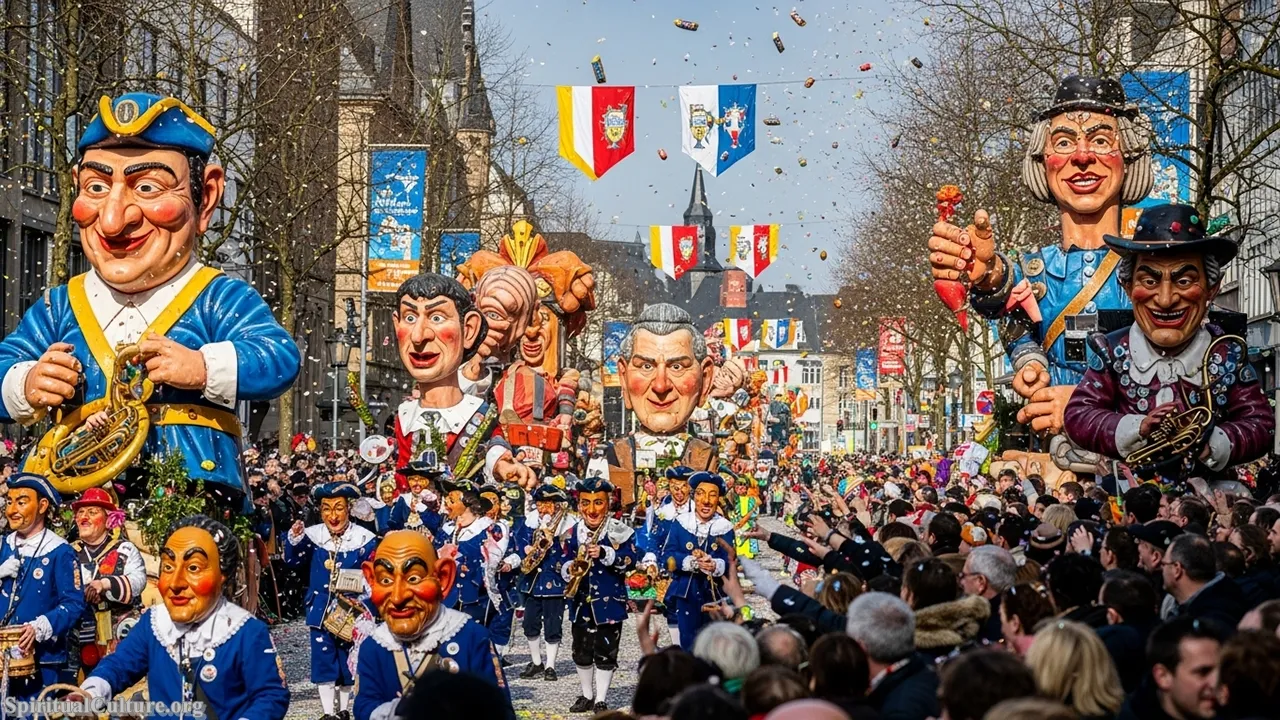
The spiritual significance of Karneval is its function as a ritualistic, pre-Lenten inversion of order and a period of social critique. It is a final, permitted explosion of indulgence (Fastnacht literally means ‘eve of the fast’) before the solemn 40 days of abstinence. Furthermore, its roots trace back to ancient pagan rituals intended to drive out the winter spirits through noise and masking. The masks often represent folk figures, jesters, and even devils, in a spiritual performance designed to mock and control the chaos of the world before order is restored.
The moral lesson of Karneval is twofold: it teaches the necessity of ritualized release and the value of satirical free speech. By allowing the jester (Narr) to temporarily usurp the establishment, the tradition provides a unique space for critique, reminding society that order must also be held accountable. It is a preservation of cultural history through collective, temporary madness that ultimately leads back to spiritual reflection.
Cultural/Spiritual Highlights
- A pre-Lenten ritual of indulgence and social inversion (the world turned upside down).
- Rooted in ancient pagan rites to expel the dark spirits of winter.
- Rosenmontag parades are a major cultural platform for political and social satire.
- Provides a spiritual boundary, sharply separating celebration from the subsequent Lenten fast.
1. Weihnachtsmärkte (Christmas Markets) & Advent
The Weihnachtsmarkt (Christmas Market) and the four-week period of Advent are arguably Germany’s most influential and cherished cultural traditions, spreading their model of seasonal celebration globally. Originating in the late Middle Ages as simple markets for food and winter necessities, they have evolved into radiant, sensory expressions of communal anticipation for Christmas. As of the Current Time of Writing, from the Christkindlesmarkt in Nuremberg to countless small-town markets, these venues are the ultimate hubs for traditional crafts, foods, and the reflective warmth of Glühwein.
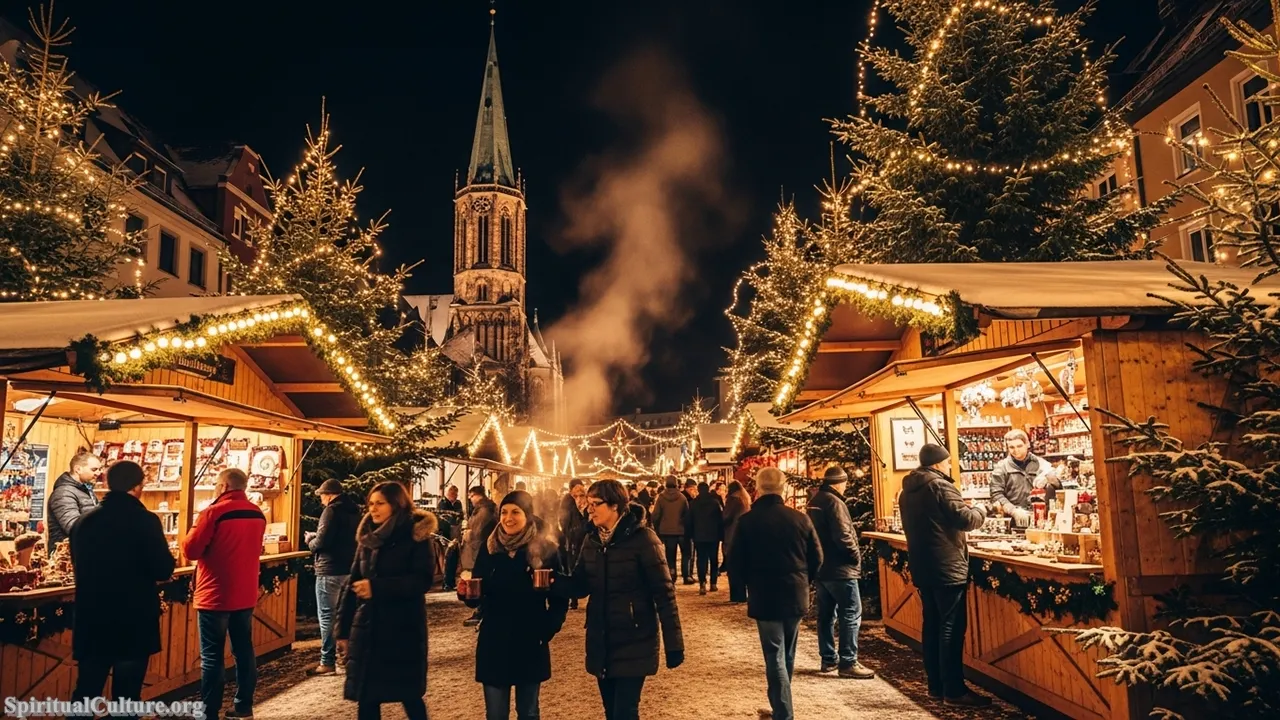
The paramount reason for this ranking is its spiritual importance: the tradition encapsulates the entire Christian Advent cycle—a period of hopeful waiting, moral reflection, and preparation for the arrival of the Christ child. The Advent Wreath (Adventskranz) with its four candles, the Advent Calendar (Adventskalender), and the market’s focus on handcrafted gifts and light in the darkest time of year all reinforce this profound, shared spiritual rhythm. It’s an immersive, cultural liturgy that transcends mere commerce, focusing on warmth, charity, and hope (Hoffnung).
The moral and preservation value is immense. It champions the handcrafted and the traditional over the mass-produced, supporting artisan heritage. More significantly, it provides a national, universally understood cultural language of coziness and collective human warmth (Gemütlichkeit). It is a lesson in patience and the spiritual beauty of anticipation, reminding the populace that the greatest joys are found in the shared journey of preparation.
Cultural/Spiritual Highlights
- Rooted in the four-week Christian liturgical season of Advent (Hope, Peace, Joy, Love).
- The market’s light in winter symbolizes the coming light of Christ into the world.
- The Adventskranz (wreath) is a central spiritual tool for family reflection and waiting.
- Preserves traditional German craftsmanship, food, and music heritage.
A Heritage of Duality and Depth
The cultural traditions of Germany, spanning the boisterous release of Karneval to the methodical discipline of Ordnung, reveal a deeply humanistic, often paradoxical national character. At Spiritual Culture, we find that the true strength of this heritage lies in its ability to reconcile these dualities: the rigorous structure of the mind with the ecstatic freedom of the heart, the solemnity of the Christian calendar with the joyous vitality of pagan seasonal rites, and the individual search for truth (Wanderlust) with the collective warmth of community (Weihnachtsmarkt). As of the Current Time of Writing, these top 10 traditions continue to provide the framework for meaning, ensuring that the German soul remains rich, resilient, and profoundly connected to its history.
By engaging with these traditions, one experiences a living history that connects the Reformation’s individual consciousness to the Romantic’s reverence for nature. We invite you to explore this cultural landscape, recognizing that every custom is a spiritual practice in disguise, a testament to the enduring quest for meaning and connection.



